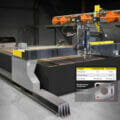~ What makes reverse bayonet connectors so reliable in challenging applications ~
In challenging applications like military and commercial transportation, electrical failure can be costly. Engineers working in these environments rely on robust and reliable electrical equipment to ensure successful operational outcomes. Here John Skinner, European Product Manager at electrical connector specialist PEI-Genesis, explains how reverse bayonets gained their stellar reputation as reliable and robust connectors for challenging applications.
Reverse bayonet connectors are often used in military, commercial transportation and industrial applications because of their relatively low cost and highly reliable design. Where intense vibrations are common for connectors used in these industries, operators need assurance that they can withstand any challenge.
So, what is it about reverse bayonets that make them one of the connectors of choice in these industries?
Rapid mating and unmating
Any coupling and decoupling system needs to be simple and efficient and must provide excellent resistance toshock, vibration and environmental contaminants to ensure the continued performance of the connector.

Originally designed for NATO combat vehicles, reverse bayonet connectors simply need a 120° turn to mate, enabling quick and easy mating and un-mating. Their design also allows the user to confirm mating in three different ways: tactile, audible and visual. The user feels the connector lock into position when mated. A loud click is heard as the three studs snap into place when the coupling nut is fully engaged.
Additionally, a coloured triangle on the receptacle aligns with a dot on the coupling nut when the connector is properly mated. These simple design features ensure that the user can be confident the connector is mated, and significantly reduce the risk of accidental de-coupling. This is critical because if, for example, reverse bayonets are being used in the communications equipment of a military vehicle, accidental decoupling because of user error or excessive vibration could negatively impact safety.
The O-ring, wave spring and washer
Reverse bayonet connectors come with either an O-ring and/or a wave spring and washer. Wave springs are specified in VG95234 and rail-specific reverse bayonets while O-Rings are used in commercial variants. These components provide the resistance when the user connects the plug to the receptacle and twists the coupling nut. The resistance gives a positive mating and prevents vibrations from making the connector loose. O-rings also ensure IP67 protection when connectors are mated.
A standard reverse bayonet connector has a mating cycle of 500 times without any decrease in performance.However, some ranges feature a wear pin on the receptacle, which increases the mating cycle to 2000 times.Not only is it better value for money to increase the lifecycle of a connector, but operators are also guaranteedhigh performance for longer.
Resilient and versatile
Above all else in harsh environments, resilience and versatility are vital. Reverse bayonet connectors offer reliable performance over a temperature range of -55 to +125 degrees Celsius as well as offering excellent shock resistance and IP67 protection when mated.
To achieve this, reverse bayonet connectors use insulators and grommets made from chloroprene. This synthetic rubber is extremely durable, is a good electrical insulator. This is important in commercial transportation, militaryand industrial settings where varying temperatures and exposure to environmental contaminates are common. For some rail applications, specialised “low-smoke” inserts are used that comply with rail industry flammability standards.
To learn more about the range of reverse bayonet connectors that PEI-Genesis supplies, visit the website at www.peigenesis.com.








